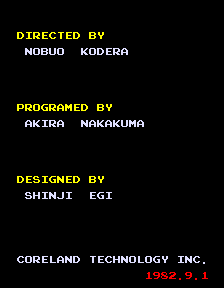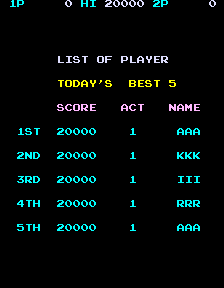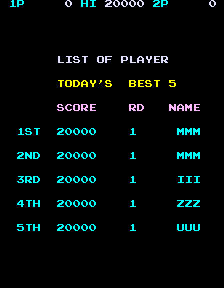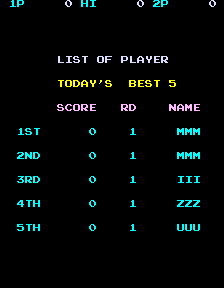If you appreciate the work done within the wiki, please consider supporting The Cutting Room Floor on Patreon. Thanks for all your support!
Pengo (Arcade)
| Pengo |
|---|
|
Developer: Coreland
|
Pengo is a Swiss stop-motion children's television series penguin who kills Sno-bees by crushing them with ice blocks.
Sometimes he'll crush the ice blocks too.
Contents
Unused Graphics
![]()
![]()
Animations for the Pengos and Sno-bees in the intro walking away from the screen. All the Pengos and Sno-bees have sprites dedicated to all of their angles in various sizes, but some of these angles aren't used.
As present in the game, the intro shows the two groups moving south while occasionally turning to show side angles, but never do they fully turn to show their backs. It's possible the path they took were once more sophisticated.
The last four levels of depth are used for the Pengos and Sno-bees until they reach a certain distance on the intro before swapping to the front and side-facing sprites.
![]()
One of Pac-Man's sprites, the sixth frame of his death animation, can be found within the game's graphic banks. This is the only remnant of Pengo being built off of Pac-Man's hardware.
Unused Music
In Sets 1 and 3 (see below), this track is played during the maze drawing sequence. It's unused in sets 2 and 4.
Hidden Credits

A hidden credits screen can be seen by holding Up and Button 1 for both players, then pressing 1P Start.
Other Developer Text
Two other chunks of developer text can be found in the main CPU. The first starts at 0x251C:
SNO-BEE DISPLAY BY NAKAKUMA AKIRA |
The second begins at 0x4D00 and gives credit to a fourth staff member. Note that each line is repeated 48 times!
1982:9:1 JAPAN :NOBUO KODERA : :TSUTOMU IWANE : :AKIRA NAKAKUMA: :SHINJI EGI : |
Revision Differences
| Set 1C | Set 2 | Set 3 | Set 4 | |
|---|---|---|---|---|
| Test Menu Bug | Yes | No | No | No |
| ACT or RD | ACT | RD | RD | RD |
| High Score Default | 20,000 | 0 | 20,000 | 0 |
| High Score Name | AKIRA | MMIZU | MMIZU | MMIZU |
| Demo Version | Old | New | Old | Old |
| Curtain Speed | Slow | Fast | Slow | Slow |
| Maze Drawing Speed | Slow | Instant | Slow | Instant |
| Main Theme | Old | New | Old | New |
| Game Flow Changes | None | All | None | Some |
There are four distinct versions of Pengo in the MAME romset: Set 1 revision C, Set 2, Set 3, and Set 4. The chronological order seems to be this:
- Set 1C
- Set 3
- Set 4
- Set 2
Most Sega-published home versions of the game appear to be based on Set 1C, retaining the ACT text and maze drawing sequences, although they usually replace the main theme with a unique song.
Test Menu Bug
In Set 1C, the test mode's dip switch display will not properly track the number of points needed for a bonus life. Fixed in all other sets.
ACT or RD
In Set 1C only, each stage is referred to as an ACT. For whatever reason, this was changed to RD in all other sets.
Default High Scores and Names
| Set 1C | Set 3 | Set 2+4 |
|---|---|---|

|

|

|
Sets 2 and 4 changed the default high score from 20,000 to 0.
Set 1C's default high score names spell out "AKIRA" vertically, the name of the game's programmer. All other sets list a "MMIZU", who might be a different member of the staff, but that name doesn't come up in the game's code at all.
Note that in Sets 2 and 4, the formatting of "RD" was changed from " RD" to "RD ".
Demo Version
Strangely, the competently played demo from the other 3 sets was altered in Set 2 so that Pengo dies almost immediately.
Curtain Speed
This is the speed of the curtain before each level. This was sped up in Set 2 so that it only lasts for a few frames.
Sets 1 and 3 will take a few seconds to draw the maze before each level starts.
This sequence was removed in Sets 2 and 4, where the maze is set up almost instantly.
Main Theme
| Old | New |
|---|---|
Probably the most significant difference. In Set 1C and 3, the main theme is an 8-bit version of the song "Popcorn".
This was changed in Sets 2 and 4 to an original track, most likely due to copyright issues. This new track would later be used in the Atari 2600 and 5200 releases, alongside being remixed for the Game Gear version.
While the newer track is longer, the old track has a feature that the new track doesn't: When time is running out, the music will speed up.
Game Flow Changes
Set 4 introduced a number of changes to make the game flow faster than in previous sets.
- Number of frames before the level completion time is shown changed from 32 to 8.
- Number of frames after a time bonus is calculated changed from 128 to 64.
- Number of frames before the screen wipes after the player has died changed from 128 to a single frame.
Additional changes were made in Set 2:
- Delay before player can move at the start of a stage changed from 64 frames to 16 frames.
- Delay before the next level loads after an intermission changed from 64 frames to 16 frames.
- Delay before the sky rapidly changes colors in the intro changed from 64 frames to 48 frames.
The Pengo series
| |
|---|---|
| Arcade | Pengo |
| Atari 2600 | Pengo (Prototype) |
| Game Gear | Pengo |
| Genesis | Pepenga Pengo |
- Pages missing developer references
- Games developed by Coreland
- Pages missing publisher references
- Games published by Sega
- Arcade games
- Pages missing date references
- Games released in 1982
- Games with hidden developer credits
- Games with unused graphics
- Games with unused music
- Games with revisional differences
- Pengo series
Cleanup > Pages missing date references
Cleanup > Pages missing developer references
Cleanup > Pages missing publisher references
Games > Games by content > Games with hidden developer credits
Games > Games by content > Games with revisional differences
Games > Games by content > Games with unused graphics
Games > Games by content > Games with unused music
Games > Games by developer > Games developed by Bandai Namco > Games developed by Bandai Namco Studios > Games developed by B.B. Studios > Games developed by Banpresoft > Games developed by Coreland
Games > Games by platform > Arcade games
Games > Games by publisher > Games published by Sega
Games > Games by release date > Games released in 1982
Games > Games by series > Pengo series
